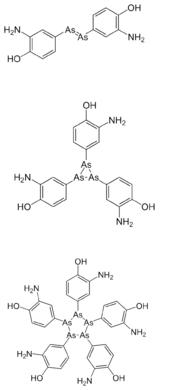Arsphenamine facts for kids
Arsphenamine, better known by its brand name Salvarsan, was a groundbreaking medicine created in the early 1910s.
This drug was nicknamed compound 606 while it was being developed. It was a special type of chemical called an organoarsenic compound. Salvarsan is considered the first modern antimicrobial agent—a medicine designed to kill harmful germs like bacteria.
Contents
The Hunt for a "Magic Bullet"
In the early 20th century, a German scientist named Paul Ehrlich had a revolutionary idea. He dreamed of creating a "magic bullet". This would be a medicine that could travel through the body and destroy disease-causing germs without hurting the patient.
Who Invented Salvarsan?
Ehrlich and his team worked hard to turn this dream into reality. In 1907, a chemist in his lab, Alfred Bertheim, created a new chemical. Two years later, in 1909, another scientist on the team, Sahachiro Hata, was testing hundreds of these new compounds.
Hata discovered that one of them was incredibly effective against the bacteria called Treponema pallidum. This was the 606th compound the team had tested, so it was given the lab name "compound 606." This was the magic bullet they had been searching for.
A Breakthrough in Medicine
The new drug was given the trade name "Salvarsan" and became available to doctors in 1910. The drug was a huge step forward.
However, the new medicine wasn't perfect. It came as a yellow powder that was very unstable and could be ruined by air. Doctors had to carefully dissolve it in sterile water right before giving it to a patient. If not prepared correctly, it could cause serious side effects like rashes and liver damage.
To make things easier, Ehrlich's lab developed a new version in 1912 called Neosalvarsan. It was easier to dissolve and prepare, but it was slightly less effective and could still make patients feel sick.
Why Don't We Use Salvarsan Today?
Salvarsan and Neosalvarsan were the best treatments available for decades. But in the 1940s, a new wonder drug was discovered: penicillin. Penicillin was much safer and more effective. It soon replaced the arsenic-based drugs, which are no longer used.
What is Salvarsan Made Of?
For many years, scientists believed Salvarsan had a simple chemical structure. They thought its arsenic atoms were linked together in pairs, with a special connection called a double bond.
But in 2005, modern technology gave scientists a closer look. Using a powerful tool called mass spectrometry, they discovered the truth. Salvarsan isn't made of simple pairs. It's actually a mix of larger molecules where the arsenic atoms form rings. Scientists now believe these complex rings are what made the drug so good at fighting disease.
See also
 In Spanish: Arsfenamina para niños
In Spanish: Arsfenamina para niños
- Arsenicin A, a natural compound containing arsenic that has similar properties.


